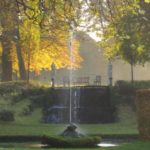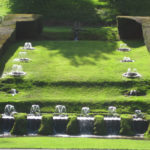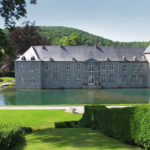The Mill of the Gardens of Annevoie
Situated in the domain of the Gardens of Annevoie, it has its own private garden. capacity: 32 persons.
Le Moulin -The Mill of Annevoie
The Big Bouillon
Charles-Alexis called this fountain “Neptune’s cuff” because of its fanlike shape, quite unusual for a “bubbler “ in the eighteenth century. It is fed with water by the Rouillon, a brook that runs across the gardens, collecting all their water before running into the Meuse.
<br/>
All plumbing in the Gardens of Annevoie is made of lead and copper. Some of it is still original; other parts are faithful reproductions by a local coppersmith. The channelling system that brings the water to the gardens is also original, as are most of the water inlets at the fountains. A well thought out concept, right from the start that is.
The Water Steps
Actually the only water steps in Belgium – if not in Europe – that have survived in perfect working order since they were constructed around 1760; and mainly because no machinery is required for their functioning. Water supply to its reservoir, the grand canal, is entirely natural by one of four springs irrigating the gardens.
The Castle on the garden side
The castle was built in several stages. The side turned to the garden gives a nice impression of the different construction stages, the first of which (small manor house to the right) dates back to 1627. You will notice that the castle as a whole has a slightly curved shape, following the curve of the Rouillon valley in which the gardens have been laid out under the inspiration of the Italian art “art adapting to nature”.
The French Drive
This great drive displays several characteristics of the French style: the care for symmetry, perspective, and the flowerbeds bordered by trimmed dwarf boxtrees, the high hornbeam fences or tree-covered walks, with their 3 sides neatly trimmed.
In springtime, you may discover various kinds of tulips. On the other hand, during the summer, in search for originality, you may come across some flowers maybe unknown to you.
The Drive of Desires
This is how Charles-Alexis, in a rather romantic mood, named the covered hornbeam lane, at the end of which a little fountain gushes from a mossy stone: the Fountain of Love.
In the middle of the bower you will perceive a boar statue inspired by Giovanni da Bologna’s bronze boar, now decorating the square of the Uffizi palace in Florence, with its snout polished by the hands of those who hope to see a wish come true. Charles-Alexis would have loved to get a copy of it in his gardens, but as a bronze one would have been too costly, he preferred to have one made in limestone. As for the wish, you may make one whilst holding down the water of the fountain of love and then let it spurt up again without getting wet.
The Stretches of water
The originality of this charming cascade is its soft murmuring sound which fits in quite well with this part of the gardens, where intimacy, silence, peace and meditation prevail. It is fed by one of the four springs, the arrival of which into the gardens can be spotted at the far end of the false grotto just behind.
Neptune's Cave
Here is another example of a « manufacture» or false grotto in which you can see a statue of Neptune, the Roman god of the sea.
All along the gardens, as in this “manufacture”, you will discover strange, flat statues. These are “trompe l’oeil”, an exclusively Walloon phenomenon. You will notice that here, sea gods like Neptune, Amphitrite, Triton, rule supreme in honour to this magnificent element called water.
The Grand Canal
This water party is the main reservoir for quite a number of fountains, cascades and water jets in the garden, supplying the necessary pressure merely by the principle of communicating vessels.
Above all, we must realize what a technical exploit such a project must have been in those days. Whereas the Grand Canal is situated on one of the slopes of the Rouillon valley, the spring that feeds it appears on the opposite slope of this valley. So, Charles-Alexis ordered the construction of pipes, 1.6 meters in diameter, skirting the valley, putting the relief to best use for his water conveyances to come sloping downhill gently until they reached the level of the Grand Canal. Wherever the relief showed too much difference in level, “dykes” were constructed, almost 10 meters in height, with his pipes running on top of them. It so happens that, whereas the Fonteny spring, feeding the Grand Canal, is only a few hundred meters away, the pipelines conveying its water are over 1 kilometre long.
The Drive of flowers
The flower garden was created in 1952 to show off a multitude of flower varieties in spring and summer. This project was a concession to the development of horticulture taste. Indeed, if flowers occupy a capital position nowadays, they certainly did not in the eighteenth century, when architectural elements prevailed (perspectives, trimmed clumps, embroidered flowerbeds with coloured gravel, etc.).
In the summer, in order to stand out against the fashion of the fifties, our gardeners have planted more contemporary, less common varieties. You will recognize cleomes, verbena, various varieties of decorative salvia, artichokes,…
Similar to the French Alley, the symmetry underlines the French influence, but the beds are laid out in English style, without the little boxwood hedges to separate them.




































